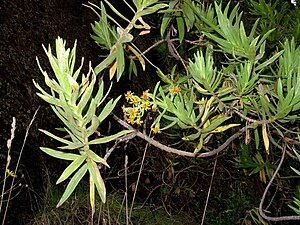
Argyroxiphium is a small genus of plants in the family Asteraceae. Its members are known by the common names silversword or greensword due to their long, narrow leaves and the silvery hairs on some species. The silverswords belong to a larger radiation of over 50 species, including the physically different genera Dubautia and Wilkesia. This grouping is often referred to as the silversword alliance. Botanist P. H. Raven referred to this radiation as "the best example of adaptive radiation in plants".

Argyroxiphium sandwicense subsp. macrocephalum, the east Maui silversword or Haleakala silversword, is a rare plant, part of the family Asteraceae. The silversword in general is referred to as ʻāhinahina in Hawaiian.

Wilkesia gymnoxiphium, is a species of flowering plant in the family Asteraceae that is endemic to the island of Kauaʻi in Hawaiʻi. It is classified as endangered on the IUCN Red List. Wilkesia is one of three genera, with Argyroxiphium and Dubautia that are believed to be descendant from a single species related to the North American tarweed. The members of these three genera constitute what is called the silversword alliance, a group whose exceedingly close genetic heritage is not reflected in their exceptionally diverse morphologies.

Argyroxiphium sandwicense, the Hawaiʻi silversword, or hinahina is a species of silversword. It is endemic to Hawaii. The two subspecies are separated by geography. Both subspecies are rare, threatened and federally protected.

The Mauna Loa silversword, Argyroxiphium kauense, or Kaʻū silversword, is a rare species of flowering plant in the aster family. It is endemic to the eastern and southern slopes of Mauna Loa on the island of Hawaiʻi. A. kauense occurs in mountainous shrublands, bogs, and open mesic forest. The species is managed by the National Park Service and Hawaiʻi State Department of Forestry and Wildlife. It is a federally listed endangered species of the United States. There are three known populations remaining, for a total of fewer than 1000 individuals.
Argyroxiphium virescens was a species of flowering plant in the family Asteraceae that was last seen in 1945. It was found only in the Hawaiian Islands where it was endemic to the eastern part of Maui. Its natural habitats were subtropical or tropical moist montane forests and subtropical or tropical high-altitude shrubland. It is officially declared extinct, but in 1989 plants were discovered that appear to be hybrids between it and the Haleakalā silversword. This hybrid is known as the Pu'u 'Alaea greensword.

Dubautia arborea, the tree dubautia or Mauna Kea dubautia, is a species of flowering plant in the family Asteraceae. A member of the silversword alliance, it is endemic to the island of Hawaiʻi. It is a shrub or small tree. It is an endangered species that is threatened by feral grazing animals.
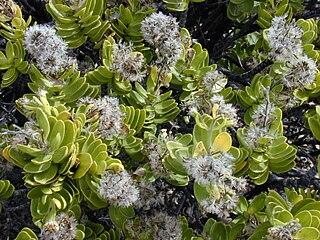
Dubautia or na'ena'e is a genus of flowering plant in the family Asteraceae. The genus was named after Joseph Eugène DuBaut (1796–1832), an officer in the French Navy who participated in Freycinet's expedition.

Madieae is a tribe of flowering plants in the family Asteraceae. It is sometimes considered a subtribe of Heliantheae. Notable species include the tarweeds of the Western United States as well as the silverswords of Hawaii.

Wilkesia is a genus of Hawaiian plants in the tribe Madieae within the family Asteraceae. It contains two perennials, both of which are endemic to the island of Kauaʻi in Hawaiʻi. Wilkesia is a component of the silversword alliance and is named after Captain Charles Wilkes.

Wilkesia hobdyi, the dwarf iliau, is a species of flowering plant in the family Asteraceae that is endemic to the island of Kauaʻi in Hawaii. It was first collected in 1968, and was not formally described until 1971. The number of living plants is estimated at fewer than 300. It is considered Critically Imperiled in global rank which means it is at very high risk of extinction. It has been a federally protected species since 1992. The genus Wilkesia is one of three genera constituting the silversword alliance, a group of highly diverse yet genetically exceedingly closely related species, all thought to be descended from a colonizing ancestor related to the tarweed of North America.
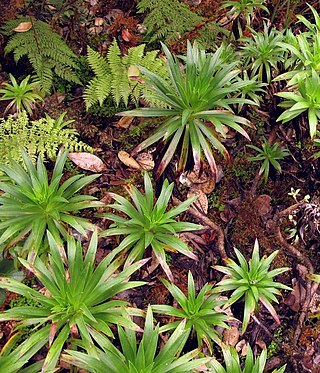
Argyroxiphium grayanum, commonly known as the greensword, is a species of flowering plant in the family Asteraceae, and a member of the silversword alliance, a group of over 50 species which are diverse in morphology and habitat but are genetically closely related.

Argyroxiphium sandwicense subsp. sandwicense, the Mauna Kea silversword, is a highly endangered flowering plant endemic to the island of Hawaiʻi of Hawaii. It is the "crown jewel" of the volcanic mountain Mauna Kea, from which it derives its English name. The Hawaiian name is ʻahinahina; it applies to silverswords more broadly. The Mauna Kea silversword was once common on the volcano, and extraordinary conservation efforts are being made to preserve the species.
Dubautia kalalauensis is a rare species of flowering plant in the family Asteraceae. It is endemic to Hawaii where it is known only from the island of Kauai. There is only a single known population composed of 26 plants. It was federally listed as an endangered species of the United States in 2010. Like other Dubautia this plant is known as na`ena`e.
Dubautia kenwoodii, the Kalalau rim dubautia, is an "extremely rare" species of flowering plant in the family Asteraceae. It is endemic to Hawaii where it is known only from the island of Kauai. Only one plant has ever been seen: the type specimen. A part of this plant was collected in 1991 and the individual was described as a new species in 1998. It was federally listed as an endangered species of the United States in 2010. Like other Dubautia this plant is known as na`ena`e.
Argyroxiphium × kai, commonly known as the Kai silversword, is a hybrid species of silversword plant in the family Asteraceae, and is a part of the silversword alliance. The name derived from the Hawaiian word "kai", which translates to "sea". It was described by David D. Keck in 1936. Argyroxiphium × kai is a natural hybrid between Argyroxiphium caliginis and Argyroxiphium grayanum, so the name Argyroxiphium calignis × grayanum can also apply, but is generally less common. It is endemic to Maui, Hawaii, where it grows between other Argyroxiphium species, primarily the two species that hybridized between each other. The population of the hybrid species is unknown, although it is likely that it may be endangered, or unstable due to invasive feral goats and pigs in its natural habitat. No conservation status has been assigned to Argyroxiphium × kai by the IUCN Red List, for it is a hybrid species, so a conservation status does not apply.
Argyroxiphium virescens × sandwicense subsp. macrocephalum, commonly known as the Pu'u 'Alaea greensword is a hybrid species of silversword plant in the family Asteraceae, and is a part of the silversword alliance. It is a hybrid between two taxons of silversword plant in the genus Argyroxiphium, being the presumably extinct Argyroxiphium virescens, and a subspecies, Argyroxiphium sandwicense subsp. macrocephalum. The hybrid species was discovered in 1989, when an individual flowered, which revealed hybridization features of two species of silversword. It is endemic to East Maui, primarily near the town of Pu’u Alaea, where it is seen growing beside other Argyroxiphium species. The population of the hybrid species is unknown, but is likely under threat of feral goats, and pigs that plague silversword plants.
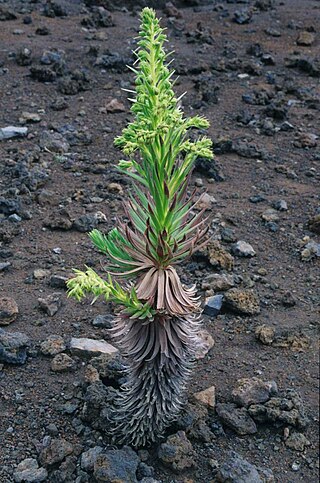
Argyroxiphium sandwicense subsp. macrocephalum x Dubautia menziesii, commonly known as the Dubautia-silversword, is a hybrid species of silversword plant in the family Asteraceae, and is a part of the silversword alliance. The hybrid was formed between Argyroxiphium sandwicense subsp. macrocephalum and Dubautia menziesii, which are both species of plant native to the Haleakalā Shield Volcano, Maui, primarily in the Haleakalā Crater, that grow in alpine and subalpine zones. A specimen was recorded by Karl Magnacca in 2006, although there isn't clear evidence of whom first described the hybrid species.
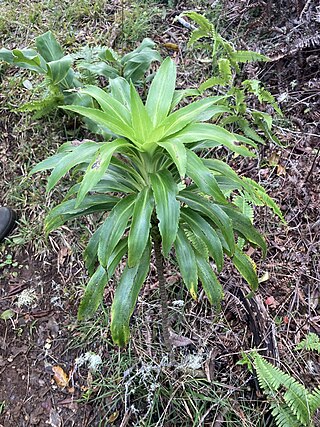
Dubautia laevigata, commonly known as the smooth dubautia, is a species of Dubautia endemic to moderate elevations on the island of Kaua'i in the state of Hawaii, United States. A member of the Silversword alliance, it only grows in the understory of mesic Hawaiian tropical rainforests. It is declining in population and is threatened by the spread of invasive species, with approximately 5500 individuals remaining.
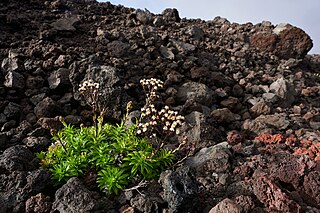
Dubautia scabra, or rough dubautia, is a species of Dubautia endemic to the state of Hawai'i and is found on the islands of Hawaii (island), Maui, Molokai, and Lanai. It is a member of the silversword alliance. Two subspecies have been described, with the nominate subspecies Dubautia scabra scabra being found only on Maui and Hawaii (island).
